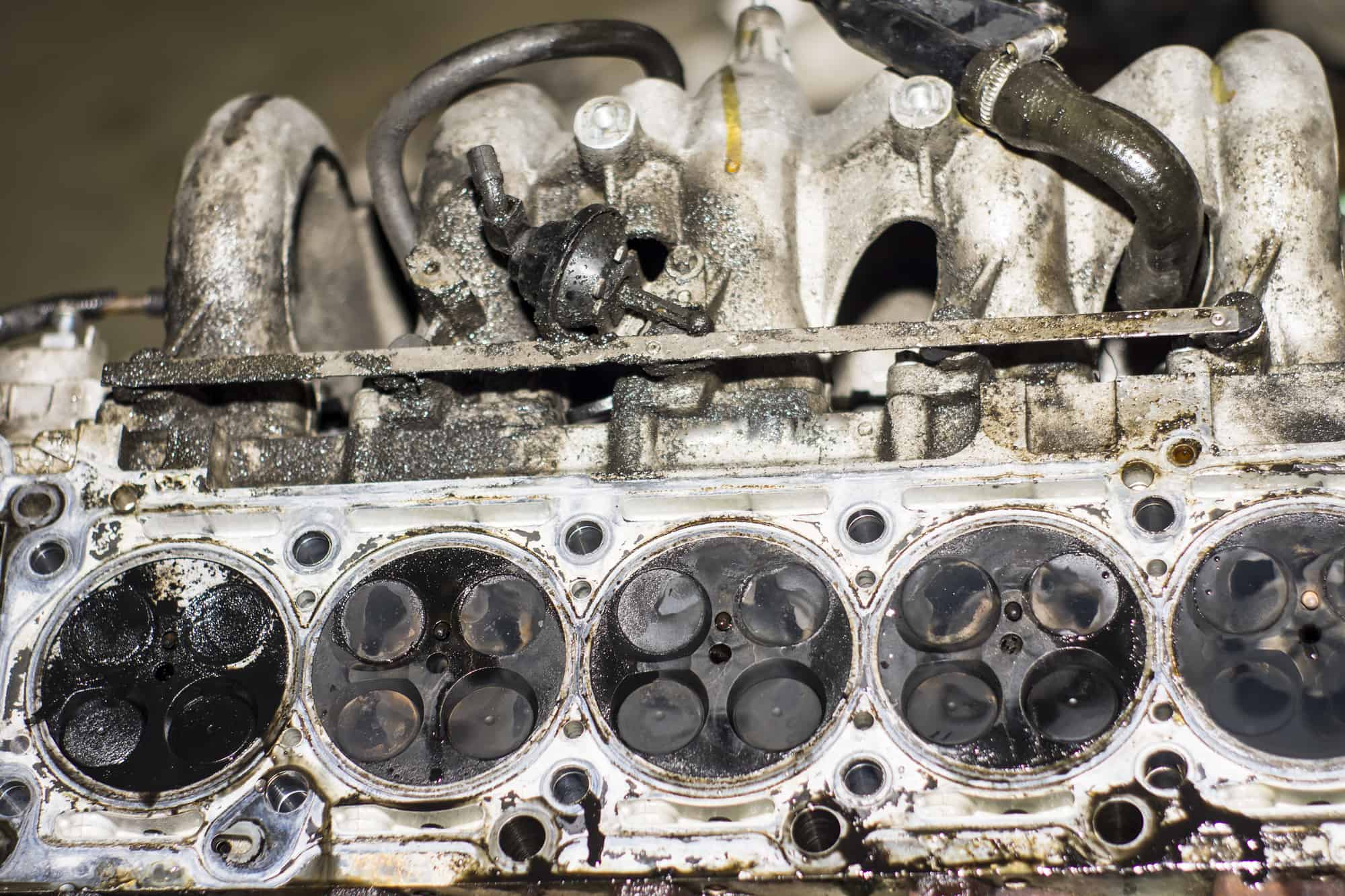The symptoms of leaky exhaust valves include an engine that is difficult to start, a rough engine when idling, a lack of engine power, knocking noise from the engine, and excessive exhaust fumes.
Leaky exhaust valves are usually caused by a problem with engine cooling, inadequate lubrication of the valve seat, excessive heat, and badly seated valves that do not seal properly with the cylinder head.
If engine exhaust valves are leaky, then they will most likely become burnt exhaust valves in a matter of months because of the high pressures and extreme temperatures they are exposed to when they no longer seal properly.
What Are The Symptoms Of Leaky Engine Exhaust Valves? (7 Common Symptoms)
| Symptom | Description |
|---|---|
| Blue-gray exhaust smoke | Leaky exhaust valve stem seals can cause oil to leak into the combustion chamber, resulting in blue-gray exhaust smoke. |
| Increased oil consumption | Leaky exhaust valve stem seals can cause oil to be burned in the engine, leading to increased oil consumption. |
| Engine idling | Leaky exhaust valve stem seals can cause engine idling to be rough or unstable. |
| Compromised acceleration power | Leaky exhaust valve stem seals can cause the engine to lose power during acceleration. |
| Engine misfiring | Leaky exhaust valve stem seals can cause the engine to misfire or run unevenly. |
| Fouled spark plugs | Leaky exhaust valve stem seals can cause the spark plugs to become fouled or coated in oil. |
| Engine damage | If left unaddressed, leaky exhaust valve stem seals can cause engine damage over time. |
Leaky exhaust valves are usually a precursor to burnt valves and worn-out valve seals. They occur when because an engine is not running properly over a period of time.
This problem can arise if there is an improper fuel mix (the engine is running rich or lean) or if there is a problem with the spark plugs or fuel supply (such as blocked injectors).
The symptoms of leaky valves often mimic those of burnt or even bent valves, so it may not be possible to fully diagnose the exact cause of the problem purely by the symptoms your engine is exhibiting.
The best way to accurately diagnose leaky exhaust valves is by stripping down the engine and examining the valves and cylinder head.
Symptom 1 – Low Compression in the cylinder
The number one symptom of leaky exhaust valves is low compression in the affected engine cylinder. When the intake and exhaust valves are closed during the compression stroke of the engine combustion cycle, the piston moves upwards and the pressure within the cylinder should increase.
A leaky exhaust valve will affect the compression level because it does not close snugly to form an adequate seal with the cylinder head. This results in air and fuel leaking into the exhaust manifold.
Low cylinder pressure affects the combustion process as the fuel does not ignite as easily or burn as thoroughly, resulting in lower engine performance.
Symptom 2 – Difficulty Starting The Engine
Another common symptom of leaky exhaust valves is an engine that is difficult to start or one that cuts out straight after starting.
For an engine to start there must be sufficient compression in the cylinder to generate enough power to ‘turn over’ the engine and continue to run after the starter motor has disengaged.
If there is a leak from one or more of the exhaust valves then this will make it more difficult to build up enough pressure within the cylinder for combustion to occur. If the leak is small, the ECU can try to compensate by adjusting the fuel-air mixture by pumping in more fuel.
A bad leaky exhaust valve will adversely affect fuel consumption and can put extra strain on the starter motor and battery, especially if the engine is frequently started in cold weather.
Symptom 3 – Rough Engine Running (Especially when idling)
Often, leaky exhaust valves may only be found in one cylinder. This can cause engine performance to fluctuate depending on the speed you are driving and the temperature of the engine.
It’s not uncommon for older engines to have one cylinder that has lower compression because of leaky or burnt valves. This may not visibly affect engine performance and depends on the type of engine and the number of cylinders it has.
Leaky exhaust valves cause more noticeable roughness when the engine is idling because there is less air getting into the cylinder and the pistons are moving slower. This means there is less crankshaft momentum to compensate for the lower pressure which leads to a rougher running engine.
Symptom 4 – Increased Fuel Consumption
Another common symptom of leaky exhaust valves is bad fuel economy.
As explained above, leaky valves will lead to lower compression during the compression stroke of the engine cycle. As the ECU is continually monitoring the engine performance it will try to compensate for the reduced power output by altering the fuel/air mix by increasing the amount of fuel.
This leads to an increase in fuel consumption and inevitably some of this extra fuel will cause corrosion and carbonization to build up on spark plug tips and around the valve seats and seals, causing further degradation in engine performance.
Symptom 5 – Knocking or puffing noise from the exhaust
A common symptom associated with a leaky exhaust valve is pulsating or knocking from the exhaust. This can feel like a puffing sensation coming from the exhaust fumes.
It can usually be displayed by placing some paper at the exhaust opening and the leaking will cause the paper to pulse in and out unevenly.
Symptom 6 – Lack Of Engine Power
One of the most common symptoms of leaky exhaust valves is a lack of engine power.
The main reason why leaky valves will lead to a reduction of engine power is because of a reduction in pressure in the affected engine cylinder, as explained above.
This is caused by a leaky valve that no longer closes fully or does not sit properly in the valve seat. It can also be caused by damage to the valve head as a result of the engine running rich.
Symptom 7 – Increased Engine Oil Consumption
Another, often less recognized symptom of leaky exhaust valves is increased engine oil consumption.
Engine exhaust valves need a constant supply of oil to remain lubricated at all times. A valve seal is used to allow the stem of the valve to be lubricated within as it moves up and down when the engine is running. This valve seal stops the oil from entering the engine cylinder, keeping it below the head of the valve at all times.
Valve seals can become damaged or burnt over time if the exhaust valve is leaking and not cooling properly if it is not sitting perfectly into the cylinder head when closed.
Burnt valve seals will leak a small amount of oil into the combustion chamber every time the valve opens and closes, and this oil can burn off when the fuel ignites.
Next Steps – How To Tell If The Exhaust Valves Are Leaking
There are a couple of different ways to determine if there is a problem with the exhaust valves. The first and most common method to determine if there are any issues is to perform a cylinder compression test.
Step 1 – Perform a cylinder compression test
This test will allow you to determine if there are leaks in the engine cylinder when the engine is running, although it won’t necessarily allow you to pinpoint the exact cause of the leak.
To perform an engine or cylinder compression test, a special compression tester tool is connected to each spark plug hole in turn and a compression reading is recorded with the engine running.
The compression readings can then be compared to see if one is significantly lower (greater than 10-15%) than the others and this can point to a leak within the cylinder.
Step 2 – Perform an engine leak-down test
A second type of test called a leak-down test can be performed to determine the ability of the engine cylinder to retain pressure.
Each cylinder is pressurized in turn using a special engine leak-down tester tool.
To begin the cylinder piston must be at ‘top dead center’ for the cylinder you are testing. This ensures that the valves are positioned so that they should be closed and the cylinder is set up so that minimum leakage should occur. This way, any leakage that is detected can be attributed to wear or damage to the valves.
The leak-down tester is connected to the cylinder via the spark plug hole and the air is pumped into the cylinder usually by a compressed air source until the pressure exceeds 100 PSI (this depends on the engine).
The leak-down tester has two gauges, one to tell you the internal air pressure of the cylinder, and the second gauge which indicates the amount of air escaping from the cylinder, read as a percentage value and this should be less than 20%.
Step 3 – Strip Down the Engine to examine the Exhaust Valves
If the pressure and leak-down tests reveal a problem with the valves, then you will need to decide if it’s feasible to fix.
If the leak-down test revealed a leak, then it may be possible to figure out the exact cause of the problem before you take apart the engine.
Once you have identified the source of the leak, the next steps involve stripping down the engine to physically check the condition of the valves, valve seals, pistons and cylinder head.
FAQ – Symptoms of Leaky Exhaust Valves
1. What happens if an exhaust valve is leaking?
If an exhaust valve is leaking then the valve head or valve seal may be damaged and this may prevent it from closing properly. A damaged exhaust valve will usually not sit perfectly into the cylinder head during the compression part of the combustion cycle.
This means that air and fuel vapor from the cylinder can build up around the valve head causing it to become burnt and warped which will lead to leaks and reduced pressure within the cylinder.
2. Is it ok to drive with a leaky exhaust valve?
Yes, technically you can continue to drive with a leaky exhaust valve and most exhaust valve leaks will go undetected in the early stages. If however, you are sure that there is a problem with the exhaust valves in your car then you are better off not continuing to run the engine until the leaky valves are repaired.
Leaking exhaust valves will only get worse and always lead to burnt valves, damaged valve seals, and a reduction in engine performance.











I’ve been noticing that my car is harder to start, especially on cold mornings, and there’s also been an increase in fuel consumption. Could these issues be related to leaky exhaust valves, and if so, what steps should I take to diagnose this problem myself before considering a professional mechanic?
I’ve been noticing a decline in my car’s performance and an increase in oil consumption lately. Could this be indicating a problem with my exhaust valves, and if so, what should my first steps be in diagnosing and addressing this issue?